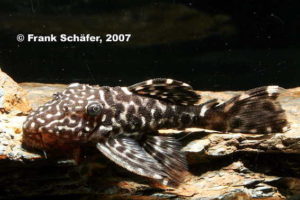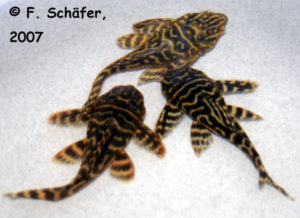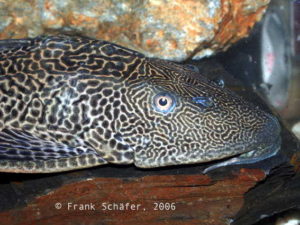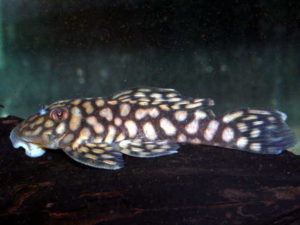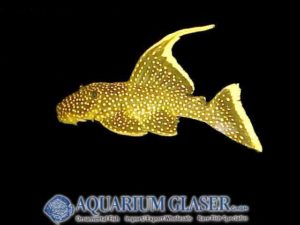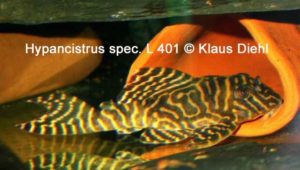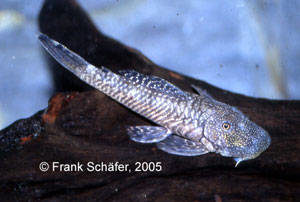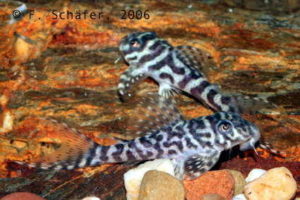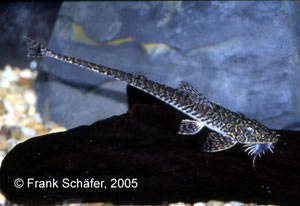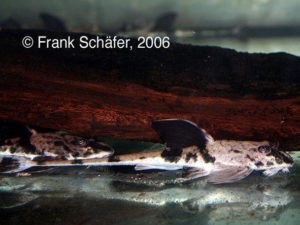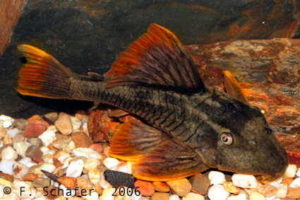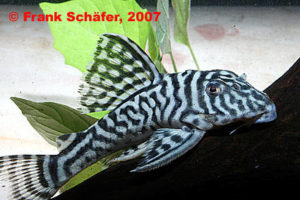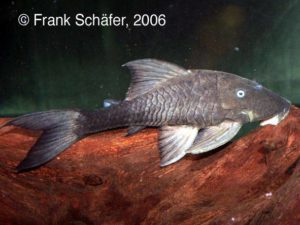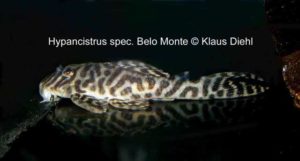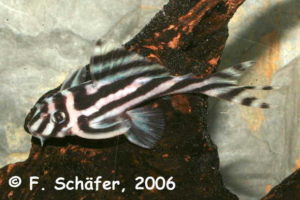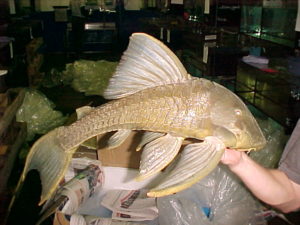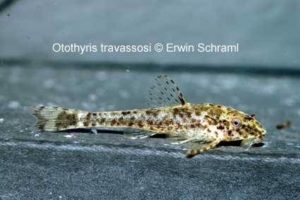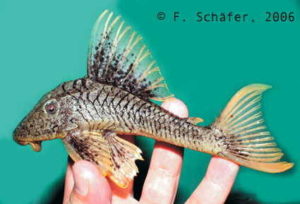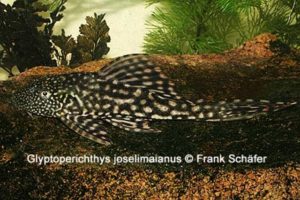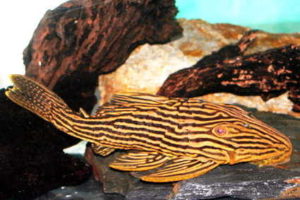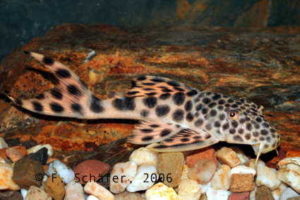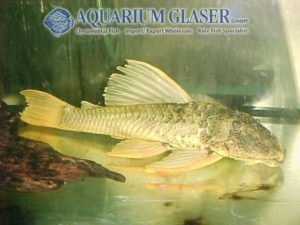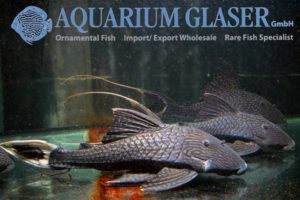April 2007: We received a particularly beautiful easter surprise this week from Colombia. The representative of the genus Leporacanthicus illustrated here is probably the first and only specimen on the market. It reminds of the in the Orinoco occurring L 240 and L 241, as well as of Leporacanthicus cf. “Venezuela”. But its white spots […]
10b. Catfishes: Suckermouths, Plecos and L-numbers (323)
-
-
Hypancistrus spec. L 340
Freshly arrived from Colombia: the Megaclown L 340. We can offer one of the most beautiful and at the same time most variable Hypancistrus “species” in very good quality. The animals already reached maturity, so that the outstanding contrast should remain. In their requirements for maintenance they do not differ from their Brazilian cousins, warm, […]
-
Liposarcus pardalis
Liposarcus pardalis has enormous area of origin that enclosure nearly the entire Amazon basin. It is found in different waters types, herefrom results a large adaptability for the maintenance in aquaria. According to the size (> 40cm) enormous food quantities are consumed. In Southeast Asia they are bred in large numbers and so wild caughts […]
-
Spectracanthicus (= Oligancistrus) zuanoni L 354
Spectracanthicus zuanoni L 354 originates from Rio Xingu and the Rio Iriri in Brazil. It has been described scientifically only in 2014 (see http://www.aquariumglaser.de/en/archiv.php?news_id=1195). The fish belongs to the same species as L 20, with however clearly larger white marks, so that the design reminds of a black net on a bright background. The reddish, […]
-
Baryancistrus sp. L-81 HIGHFIN
September 2003: This week we received from Brasil a really unique fish: L-81 HIGHFIN. Our supplier advised us to send this fish and it really was worth waiting….was it not?(Photo F. Schäfer, Text K. Diehl)
-
Hypancistrus spec. L 401
This in the DATZ 12/05 introduced very beautiful Hypancistrus variant is at present in a small number available. The animals remind in their habitus of L 333 and with these are also occasionally confounded. In the figure they are more delicate, somewhat more stretched and reach only one overall length of maximally 12 cm, while […]
-
Chaetostoma pearsei L 187
This Chaetostoma species is imported in regular intervals from the upper Orinoco through Puerto Ayacucho. This catfish is very difficult to differentiate from L 147 and L 188. L 188 has often described in the literature as C. nudirostre. C. pearsi lives in fast streaming mountain brooks and therefore needs in the aquarium oxygen rich […]
-
Hypancistrus spec. L 66 „King Tiger“
As one of the early imported representatives of the so-called L-number catfishes L 66 has already an unbroken popularity. At present we can offer beside wild caughts also very beautiful german breds. Such bright grounded L 66 are at least as attractive as the most „newer“ Hypancistrus species. With a final size of approx. 15 […]
-
Crossoloricaria cf cephalaspis
The 5 species of the genus Crossoloricaria are all looking very similar to the flounder Loricariid genus Pseudohemiodon. These fish have as well a flattened body form, small eyes lying distally on the triangularly formed head. The difference between these two genii is the missing of the ventral bony plates of Crossoloricaria. Only at the […]
-
Loricaria simillima
Loricaria simillima has a very wide distribution in South America. It is found in the Orinoco-, Amazon- and La Plata basins. A result of this large area many different color forms are known, which differ clearly regarding coloration and pattern. The species occurs in different water types. Black water forms are more demanding in maintenance […]
-
Cochliodon sp. YELLOW SEAM L 360
From the Rio Jamanxim in Brazil we could import a small number of L 360 with nice yellow-orange fins. They are unproblematic in the maintenance need however a high portion of vegetables in their food. Similar as Panaques this over 30 cm large growing species specieseats large quantities ofr bogwood. A high performance filtering unit […]
-
Hypancistrus spec. NEW
September 2006: Latterly we received this very rich contrasted male of an unknown Hypancistrus species. Certainly here exists a similarity to L 333 and also Hypancistrus spec. Xingu. It gets more and more difficult to attach single fishes to existing L numbers or to a known Hypancistrus species, because there are not enough hard criteria […]
-
Panaque cochliodon
December 2005: After years when no Panaque cochliodon (Panaque suttoni, P. suttonorum) were imported, now again few individuals reach us. Whether environmental problems or the civil war in parts of Colombia are responsible for their non appearence, can not be judged from a distance. We are glad to see this in former times not rare […]
-
Hypancistrus spec. „Belo Monte“ (L 287, L 399, L 400)
The denomination of this beautiful Hypancistrus is still disputed. It run long time under the number L 287, so it is named on our stock list. Recently it is called L 399 and/or L 400, the origin is the Rio Xingu, where it gets caught in the neighbourhood of Belo Monte. This species belongs into […]
-
Hypancistrus zebra L 46 „Double Tailfin
November 2006: At present we can offer beside „normal “German bred zebras (surely the most demanded of all L-numbers) an individual with a doubled lower caudal fin. This change of the fin is probably to be led back on a disturbance in the embryonic development. If someone hopes to breed a race of „veil tailed […]
-
Panaque spec.
June 2006: Just freshly arrived! Also for „old stagers“ there are again and again genuine surprises with us. In a shipment from Peru we received today several particularly delicate Loricariids, which represent a petite alternative to the frequently maintained Hypancistrus species. However their size of (50 – 70 cm) probably exceeds the possibilities of most […]
-
Otothyris travassosi
This rarely imported catfish species originates from the federal states Bahia and Espirito Santo at the coast of brazil. With only 3cm of total length it belongs to the smallest Loricariids. There habitats are small and fast running streams. They mostly stay in areas thickly covered with vegetation. Otothyris travassosi is not a fish for […]
-
Cochliodon spec. var. marbled L 360a
From the drainage basin of the Tapajos arrived a new, until now not imported loricariid catfish at our facility. Body form and yellow fin seams remind strongly of L 360, the body and parts of the fins however exhibit a veining atypical for L 360. In their maintenance requirements they might probably not differ from […]
-
Glyptoperichthys joselimaianus L 1, L 22
Glyptoperichthys joselimaianus the “White Spot – Glycopterichthys” originates from the Rio Araguaia, one of the main tributaries of the Rio Tocantins in Brazil. There it inhabits different habitats, it was found e.g. on deadwood and also on flooded meadows. Natural water conditions (white water) do not have to be copied for maintenance, L 1 are […]
-
Panaque spec. „New Royal Golden Thunder“
September 2006: This week we succeeded in importing several of this beautiful new Panaque from Brazil. In their appearance they remind of L 27, are however flatter and slimmer than these. In addition they possess a larger mouth and their dorsal fin is smaller. These characteristics let assume that they originate from strongly flowing river […]
-
Ancistomus sabaji L124 „Big Spot“
Ancistomus sabaji – Hypostomus spec., Peckoltia spec.? A fish with many names! There is hardly another L number catfish where the confusion regarding the nomenclature is as large as with this species. This is a result of the generous allocation of numbers (L 75, L 124, L 301 and LDA 2) for this fish. One […]
-
Hypostomus luteus
From southern Brazil and northern Argentina originates the probably most beautiful representative of the genus Hypostomus. Contrary to many other loricariids they become more beautiful with increasing age, since the portion of the yellow body parts constantly increases. Their southern area of origin suggests a tolerance in relation to low temperatures. They can be can […]
-
Panaque spec. „Papa Ojo Chico“ L 90a
With L 90a we can offer at present one of the most beautiful Panaque species. Especially the extremely long, orange colored filaments of the caudal fin are remarkable. In addition, the discrete black markings on the noble-grey colored body let them appear very elegant. With the purchase of these fishes their final size (over 30cm) […]





